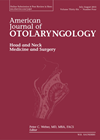
Journal Reviews
Does transoral robotic surgery improve outcomes among patients with head and neck cancer of unknown primary?
A tonsillectomy and tongue base mucosectomy is becoming increasingly accepted as the optimal surgical intervention to aid in identifying the primary source of a p16+ / HPV-related squamous cell carcinoma (SCC) of unknown origin, given that this disease almost exclusively...
Gastrostomy tube dependence following TORS
Transoral robotic surgery (TORS) for oropharyngeal squamous cell carcinoma (OPSCC) is now a well-established treatment modality for early (T1-T2) disease. Accumulating evidence suggests that one of its main benefits relative to conventional chemoradiotherapy is superior long-term functional outcome, especially with...
Is there a limitation for excising parapharyngeal tumours transorally?
The parapharyngeal space is a complex anatomical space bounded medially by the oropharynx and laterally by the mandible. It is conceptualised as an inverted pyramid extending from base of skull above to the hyoid bone below. The space is divided...
Automated contouring of costal cartilage for pinna reconstruction – a proof of concept
Presently there are limited applications of automation within operative ENT. This proof-of-concept study explores the use of an augmented robot to contour cadaveric costal cartilage for auricular reconstruction. Ordinarily this task is performed manually. This takes considerable time due to...
Narrow band imaging in the management of carcinoma of unknown primary
This was a retrospective study to assess the utility of narrow band imaging (NBI) in the detection of a primary site in carcinoma of unknown primary (CUP). Patients with CUP who underwent transoral robotic surgery (TORS) and preoperative imaging with...
Preventing major postoperative haemorrhage following TORS
Transoral robotic surgery (TORS) has become an increasingly utilised treatment modality in the management of oropharyngeal squamous cell carcinoma (OPSCC). Postoperative haemorrhage, although uncommon, is a significant complication. To ameliorate this risk, transcervical ligation of branches of the external carotid...
Outcomes for transoral vestibule approach thyroid surgery
Ed’s choice explores a systematic review examining one of the recent innovations in head and neck surgery. It may come as a surprise to some that within a few years of the first published cases of transoral vestibule thyroidectomy, an...
Which da Vinci surgical system? Novel flexible, single-port versus current multiport, rigid-arm robotic surgical system
The da Vinci robotic surgical system has transformed how oropharyngeal head and neck surgery can be delivered. The existing da Vinci Si model has challenges: the dimensions of this are larger than would be ideal for head and neck surgery...
The newest robot from da Vinci – what can it offer for hypopharyngeal cancer surgery?
The standard existing da Vinci surgical robot (the Si model) has been much maligned for not being optimally designed for transoral access and endoscopic manoeuvrability in head and neck surgery. This preclinical work from Holsinger and his team looks at...
Advances in surgical innovation for head and neck cancer
This article reviews current advances in surgical treatment of head and neck cancers such as sentinel node biopsy, stereolithic modelling, transoral robotic surgery and intra-operative imaging of tumour margins. Sentinel node biopsy has been found to be especially useful for...
What is the evidence for contralateral tonsillectomy in TORS for known unilateral tonsil malignancy?
The concept of field changes by carcinogens within the upper aerodigestive tract is well established with reported rates of synchronous tumours of 4% and second primaries of 36%. The tonsil in particular has the highest rate of synchronous tumours, postulated...
Risk factors for TORS treatment failure in HPV-related oropharyngeal cancers
HPV-related squamous cell cancers are an increasingly common cause of malignancy in the oropharynx. There is evidence that these cancers are associated with a significantly improved overall survival compared to conventional HPV-negative tumours. The optimal treatment for such cancers is...

















